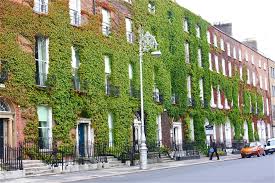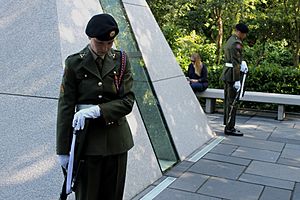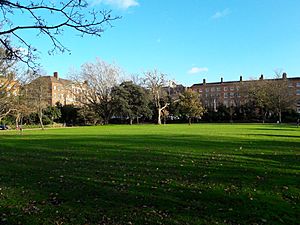Merrion Square facts for kids
Quick facts for kids Merrion Square |
|
|---|---|

Georgian façade of Merrion Square
|
|
| Lua error in Module:Location_map at line 420: attempt to index field 'wikibase' (a nil value). | |
| Type | Georgian garden square |
| Location | Dublin, Ireland |
| Area | 4.73 hectares (11.7 acres) |
| Created | 1762 |
| Operated by | Dublin City Council |
Merrion Square (Irish: Cearnóg Mhuirfean) is a famous Georgian garden square located on the south side of Dublin city centre in Ireland. It is known for its beautiful old buildings and the lovely park in its middle.
Contents
History of Merrion Square
This special square was first planned in 1752 by a wealthy family called the FitzWilliams. Most of the buildings were finished by the early 1800s.
People wanted to build large, fancy homes south of the River Liffey. This was because a very important person, the Earl of Kildare, decided to build his huge Dublin home there. His home, Leinster House, was the biggest private house in Dublin.
Because of this, three new residential squares were built on the south side: Merrion Square, St Stephen's Green, and Fitzwilliam Square. Rich families and important people then moved from the north side of Dublin to these new, fashionable areas.
What You See Today
All the original buildings from the 1700s in Merrion Square are still standing. Three sides of the square have these beautiful red-brick Georgian houses. The west side of the square is next to the grounds of Leinster House, which is where the Irish parliament (Oireachtas) meets. You can also find Government Buildings, the Natural History Museum, and the National Gallery nearby.
The large garden in the middle of the square is now a public park for everyone to enjoy. A big monument for a famous general, Arthur Wellesley, 1st Duke of Wellington, was once planned for Merrion Square. However, the people living there didn't want it, so it was built in Phoenix Park instead.
Who Lives and Works Here

For a long time, people lived in the houses around Merrion Square. But now, most of them are offices for different companies and groups. For example, the Irish Red Cross and the Royal Institute of the Architects of Ireland have their main offices here. The National Maternity Hospital is also on the north side of the square.
Many famous people have lived in Merrion Square. The famous writer Oscar Wilde lived at No. 1. The poet W. B. Yeats lived at No. 82, and the important political leader Daniel O'Connell lived at No. 58. Today, No. 58 is known as O'Connell House and is part of an American university.
Some houses have special plaques that tell you about the famous people who used to live there. Even though many buildings are now offices, some people still live in Merrion Square today.
Until 1972, the British Embassy was located at No. 39. After a sad event in Northern Ireland called Bloody Sunday, a large protest happened at the embassy, and the building was badly damaged by fire. Today, the Embassies of France and Slovakia are on the south side of the square.
Merrion Square Park
The park in Merrion Square was first designed with a double line of trees around its edges. Later, railings were added to enclose it. The park was designed in a natural, English garden style with rolling grass, groups of trees, and winding paths.
For many years, until the 1960s, only people living in the square who had a special key could enter the park. Now, Dublin City Council manages the park, and it is open to everyone.
The park has a statue of Oscar Wilde, who lived nearby for many years. You can also find other sculptures and a collection of old Dublin lamp standards there. An Irish American sculptor named Jerome Connor created a public art piece called "Eire" in the park. There is also a sculpture of a Joker's Chair, which remembers the comedian Dermot Morgan, who starred in the TV show Father Ted.
The park was once called "Archbishop Ryan Park." This was after a Catholic archbishop named Dermot Ryan gave the park to the city. In 2010, Dublin City Council decided to rename it Merrion Square Park, which is its original name.
The park was also used for many years by the St John Ambulance Brigade for their events and first aid competitions. This organization helped people during the First World War and had its headquarters on Merrion Square for a long time.
Images for kids
-
The Joker's Chair, built in memory of comedian Dermot Morgan




